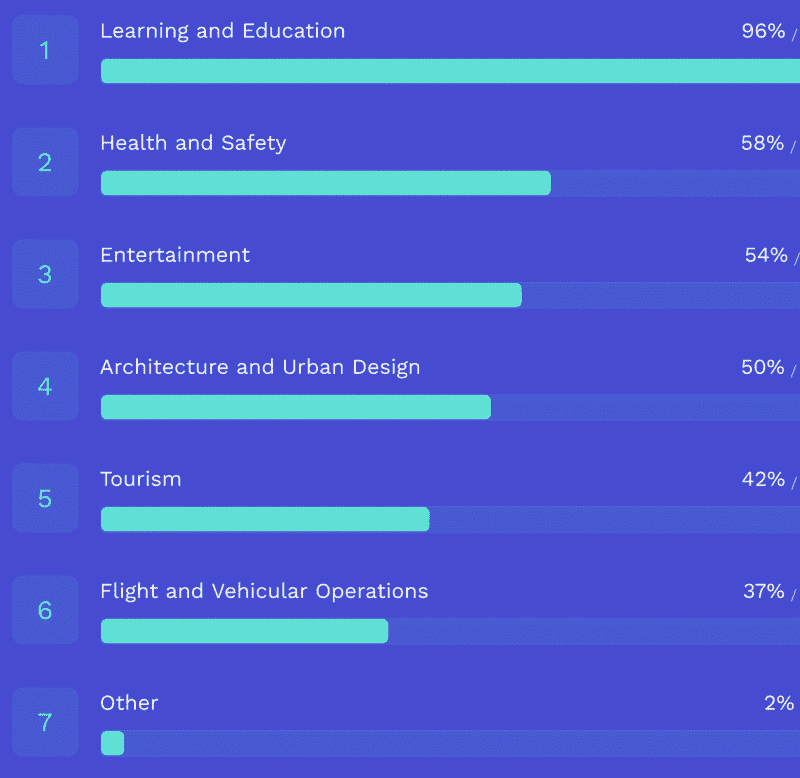With digital learning taking centre stage in these disruptive times, the key concern for some talent development practitioners remains how to effectively deliver high-risk and complex training within the same digital sphere. Nay-sayers have moved swiftly to put out the possibilities, but this has mostly been predicated on ignorance.
Although VR, AR, MR, and XR might no longer be technical buzz words seizing the attention of all, we still find the absence of awareness of their inherent technologies even within the corporate world. 61.4% of respondents polled in our Virtual Reality Application Survey had little or no knowledge of virtual reality.
For introductions, let us onboard you with the following definitions (just in case you are part of the 61% above)
- Virtual Reality (VR): is the immersion of a single user within an entirely virtual environment (3D) especially through vision (we can also embed sounds and movements in this virtual world)
- Augmented Reality (AR): involves the augmentation of UI elements, data, information and objects within the user’s current real-world environment mostly on wearable devices, e.g. augmented help icons seen through a Google glass when viewing a car engine.
- Mixed Reality (MR): is the addition of 3D virtual elements in the real world. Think of this as the co-existence of real and virtual objects (Some people look at AR and MR as the same thing while others term this as the combination of VR & AR). The key feature of MR is the possibility of interactivity between real-world objects and virtual objects
- Extended Reality (XR): This is an umbrella term used to describe all the technologies within this sphere and preclude public confusion associated with the terms.
The above technologies provide the opportunity to simulate concepts which would traditionally have been tough to capture. With XR, competencies requiring high physical interaction and demonstration, and requiring complex training can now be delivered to the comfort of learners and employees at the comfort of their homes.
The devices required to harness these immersive trainings include smartphones, personal computers (the usual suspects), VR headsets, MR headsets, XR gloves and bodysuits, and XR controllers. While personal computers are readily available, there has been a reduction in the prices of VR, MR, and XR devices making them available for the end-users or easily acquired by organisations for implementing VR academies.
What industries and applications do we see immersive technology reshaping?
88% of our respondents (from early joiners to executives) agree VR will be useful and relevant in the workplace and other areas of life.
Fig. 1: Job role distribution for respondents
Fig. 2: Response: I know VR will be useful and relevant in the workplace and other areas of life
Learning & Education, followed by Health and Safety, leads the functions/industries where our respondents predict VR will enable digitisation and disruption:
Fig. 3: Response: I will like to see Virtual Reality applied in the following functions/industry? hopefully, I can also give it a try)
Our specific thoughts on viable application areas and functions:
- Immersive consumer-grade VR applications and digital training for scenario-based concepts such as leadership skills, emotional intelligence, anger management will enable real-life portraying of issues and quicker adoption and retention for learners
- Equipment/Practical Training: L&D practitioners can now adopt VR to remotely develop employees in equipment training, device walk-throughs, new site visits amongst others
- Health & Safety: With XR adoption, disaster recovery scenarios can be activated virtually while allowing learners to experience best practice responses for fire, accidents etc. without having to experience them physically.
Quick benefits include:
- The ability to deliver these training in restricted conditions as currently experienced globally.
- More efficient use of training costs (travel and logistics reduced)
- The ability to deliver such costly trainings in controlled environments (e.g. replicating a fire scene virtually).
The time to take the next digital step is now, but you must do it right even if you need to move fast. Implementing XR might seem a daunting task, but partnering with a digital learning expert might save you the learning curve with faster traction and results. Also, you do not need to begin by picking all at once, just pick the exact colours in your crayon box fitting for your canvas. With the right partnership, you can adopt and implement XR as part of your digital learning offerings blended with traditional instructor-led sessions aligned to an extensive and robust learning and development framework.
Written by:
Olayemi Olatunji

Senior Consultant




